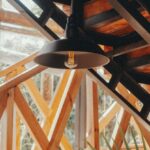When it comes to decorating and designing high-ceilinged rooms, the challenge of dealing with echoes is a common concern. These spacious areas can often amplify sound, creating a less than ideal acoustical environment. Whether it’s in a grand living room, a loft apartment, or a commercial space, minimizing echo in high-ceilinged rooms is essential for creating a more comfortable and functional space. Here are some effective strategies to help you tackle this issue and improve the acoustics in your lofty room.
Choose the Right Furniture and Textiles
Selecting the right furniture and textiles can play a significant role in minimizing echo in high-ceilinged rooms. Opt for plush sofas, upholstered chairs, and soft furnishings that can help absorb sound rather than reflect it. Additionally, adding area rugs, curtains, and tapestries can help dampen sound waves and reduce reverberation. Textured materials and fabrics with a heavy weave are particularly effective at absorbing sound, so consider incorporating these into your decor to help soften the acoustics of the space.
Strategic Placement of Furniture
Strategically placing furniture can also help to break up sound waves and reduce echo in high-ceilinged rooms. Positioning large pieces of furniture such as bookshelves, cabinets, and room dividers along walls can help to absorb sound and prevent it from bouncing around the room. Creating separate seating areas with furniture can also help to break up the space and reduce the overall echo. Experiment with different furniture arrangements to find the optimal layout that minimizes echo and enhances the acoustics of the room.
Utilize Sound-Absorbing Materials
Incorporating sound-absorbing materials into your high-ceilinged room can make a significant difference in minimizing echo. Consider installing acoustic panels on walls or ceilings to help absorb sound waves and reduce reverberation. These panels come in a variety of shapes, sizes, and colors, making them a versatile and effective solution for improving acoustics in large spaces. Additionally, adding sound-absorbing materials such as cork, fabric-wrapped panels, or acoustic tiles can help to further dampen sound and create a more pleasant auditory environment.
Add Soft Furnishings and Decorative Elements
In addition to furniture and textiles, incorporating soft furnishings and decorative elements can also help to minimize echo in high-ceilinged rooms. Adding throw pillows, cushions, and blankets to seating areas can help to absorb sound and prevent it from bouncing around the room. Hanging tapestries, artwork, and decorative wall hangings can also help to break up sound waves and reduce reverberation. Choose items with texture and depth to maximize their sound-absorbing properties and enhance the acoustics of the space.
Create Visual Interest with Ceiling Treatments
In high-ceilinged rooms, the vast expanse of ceiling space can contribute to echo and reverberation. By incorporating ceiling treatments such as suspended acoustic panels, ceiling clouds, or decorative beams, you can help to reduce echo and add visual interest to the room. These treatments not only serve a practical purpose in absorbing sound but also create a more intimate and visually appealing atmosphere in the space. Experiment with different ceiling treatments to find the right balance between form and function in minimizing echo in your high-ceilinged room.
Opt for Area Rugs and Carpeting
One of the simplest yet most effective ways to minimize echo in high-ceilinged rooms is to incorporate area rugs and carpeting. These soft floor coverings can help to absorb sound and reduce reverberation, especially in rooms with hard flooring surfaces such as tile or hardwood. Place area rugs strategically in seating areas, under dining tables, or in high-traffic areas to help dampen sound and create a more acoustically pleasing environment. Choose rugs with a thick pile or dense construction for maximum sound absorption and impact.
Experiment with Soundproofing Solutions
If echo remains an issue in your high-ceilinged room despite implementing the above strategies, consider exploring soundproofing solutions to further enhance the acoustics of the space. Installing soundproofing materials such as acoustic foam panels, soundproof curtains, or soundproofing insulation can help to minimize echo and create a more soundproof environment. Additionally, sealing gaps and cracks in windows, doors, and walls can help to prevent sound from entering or escaping the room, further enhancing the acoustical properties of the space.
Conclusion: Enhance Your High-Ceilinged Room Acoustics
In conclusion, minimizing echo in high-ceilinged rooms is achievable with the right strategies and design elements. By selecting the appropriate furniture and textiles, strategically placing furnishings, incorporating sound-absorbing materials, adding soft furnishings and decorative elements, creating visual interest with ceiling treatments, opting for area rugs and carpeting, and experimenting with soundproofing solutions, you can effectively enhance the acoustics of your lofty space. With a thoughtful approach to design and acoustics, you can transform your high-ceilinged room into a more comfortable, functional, and acoustically pleasing environment.





